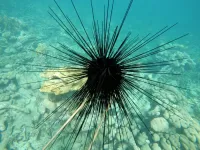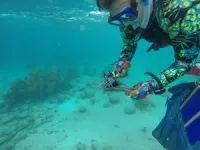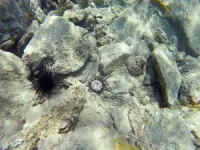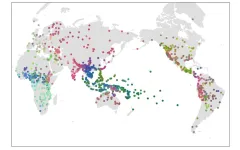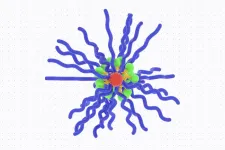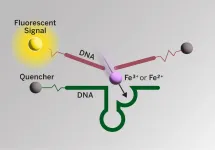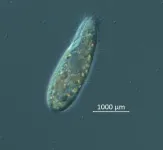(Press-News.org) The long-spined sea urchin Diadema antillarum is a keystone species. Coral reefs rely on healthy sea urchins to eat algae so coral can thrive. Healthy coral means healthy fish, and their positive impacts continue up the food chain.
In early 2022, long-spined sea urchins in St. Thomas began to quickly die in large numbers. Scientists rushed in to find the cause and have discovered that a microscopic parasite swarms the body and spines of the urchins, eating them alive.
The culprit, a microscopic organism called a scuticociliate, appears most similar to Philaster apodigitiformis, a type of protozoan parasite. It began decimating sea urchin populations around the Caribbean, and within days of being symptomatic, urchins were dying. In a matter of months, losses were reported in nine more locations across the Caribbean, including off the Florida coast.
“The research team was still processing samples from the last site where a die-off occurred when we would get calls about a new location with dying urchins,” said Don Behringer, UF/IFAS professor of marine disease ecology and lead on a National Science Foundation RAPID grant that made the work possible. Behringer is also a member of the UF Emerging Pathogens Institute. “It only took a couple weeks for the majority of the long-spined urchins to be wiped out at a specific site. Rapid-response funding like this allows us to go to locations to sample and assess environmental conditions quickly and learn from it.”
Mass mortality events of this size can fundamentally change marine ecosystems for the worse. The most recent sea urchin die-offs were like those that occurred in 1983, when 98% of sea urchins were lost in 13 months. Researchers never discovered the cause of that die-off, which left many questions regarding protection of reefs from future events like it. Some coral reef systems never recovered and still feel the effects of those losses today nearly 40 years later. Some reports state that urchin populations at impacted reefs have only reached 12% of what they were before the 1980s mortality event.
“We had to act very fast. You really have to act within a week or two, or you’ll lose your chance,” said Ian Hewson, Cornell University marine ecology professor whose lab focuses on marine diseases. “These mass die-offs usually blow through extremely fast and sometimes if you get there too late, you’ll only be left with diseased animals and won’t even know what ‘normal’ looks like.”
Researchers identified the parasite relatively early on and validated their discovery through a series of experiments. They started with analyzing fluid from the urchins’ bodies, which is comparable to a blood sample, where they first discovered the parasite. From there, they isolated the pathogen and let it multiply. Then, they needed to confirm in a controlled setting that the identified pathogen was causing the deaths.
“We were really lucky to have access to urchins that were raised in a controlled environment and that we knew had not been exposed to the ciliate,” said Behringer.
Urchins are difficult to hand rear in aquaculture environments. UF/IFAS associate professor of restoration aquaculture Josh Patterson, in partnership with The Florida Aquarium, has learned how to hand rear the animals. His primary goal is to raise urchins for release into the wild to help restore coral reefs, but in this case, the healthy urchins helped validate the researchers findings out in the field.
“When this disease went through the Caribbean, it was impossible to know which urchins pulled out of water were exposed to the parasite,” said Patterson. “We had cultured urchins in tank that were naïve, known to be uninfected, that could help confirm what was causing the mass deaths of urchins in the wild.”
Those healthy urchins, raised in Patterson’s lab, were taken to the University of South Florida to be infected with the ciliate. Within four days, the previously healthy urchins were showing signs of illness, confirming the parasite to be the offender.
“Other parasites similar to this one are known to cause disease in other organisms but have not been implicated in urchin disease outbreaks, in the Caribbean or elsewhere,” said Behringer. “It appears to act in a micropredation mechanism where it swarms the urchins and starts multiplying and rapidly eating away at them.”
Researchers are unsure why the parasite struck when it did or what caused it to be so voracious, but that is a question they hope to answer in the future. The information gained from this research has prompted further questions that will help scientists understand the parasite and the long-term effects of these die-offs on coral reefs.
And what about the die-offs in the ’80s? Could this parasite have been the culprit then, too?
Unfortunately, there are no remaining tissues or samples available from urchins impacted by the 1983 mass mortality event. Even though scientists have no way to compare this event to historical losses, the information gained from the 2022 event can help conserve populations in the future.
“We documented current algae coverage, urchin abundance and other species present before, during, and after the die-offs,” said Behringer. “We can use this information as a baseline from which we can compare a year, two years, five years, 10 years and beyond. It helps us create a clearer picture of the impact urchin loss has on the condition of the reefs and the broader reef community. We’re fortunate we had the opportunity to collect the data we did.”
As of December 2022, it seemed that the die-offs had stopped. In some areas, new urchins were being reported, a good sign of recovery. However, just recently, new reports of dying urchins have come in from the Cayman Islands and U.S. Virgin Islands.
“We cannot say for sure if it is the return of the same parasite, but it appears ominous,” said Behringer.
“The previous die-off was extremely consequential for the reefs that were impacted and some never recovered,” said Behringer. “This time we know the culprit and are trying to figure out how and why it emerged.”
This project would not have been possible without the support of many, including the funding agencies, the National Science Foundation, Florida Sea Grant, National Oceanic and Atmospheric Administration and the National Fish and Wildlife Foundation. Special thanks to the project partners including the University of South Florida, University of the Virgin Islands, Virgin Islands Government and many more.
END
Scientists discover cause of sea urchin die-offs in the Caribbean: a protozoan parasite
2023-04-19
ELSE PRESS RELEASES FROM THIS DATE:
How opioid drugs get into our cells
2023-04-19
The human body naturally produces opioid-like substances, such as endorphins, which block the perception of pain and increase the feeling of well-being. Similarly, opioid drugs, including morphine or fentanyl, are widely used for alleviating severe pain. However, their use is associated with a high risk of dependence and addiction, and their excessive misuse causes over 350,000 annual deaths worldwide. Researchers from the University of Geneva (UNIGE) have compared the action of natural and therapeutic opioids. The latter penetrate inside the cells ...
Grambank shows the diversity of the world's languages
2023-04-19
Linguists have long been interested in language variation. What are common or universal patterns across languages? What limits the possible variation between them? Grambank, the world's largest and most comprehensive database of language structure, enables researchers to answer some of these questions.
Grambank was constructed in an international collaboration between the Max Planck institutes in Leipzig and Nijmegen, the Australian National University, the University of Auckland, Harvard University, ...
Nanoparticles provoke immune response against tumors but avoid side effects
2023-04-19
CAMBRIDGE, MA — Cancer drugs that stimulate the body’s immune system to attack tumors are a promising way to treat many types of cancer. However, some of these drugs produce too much systemic inflammation when delivered intravenously, making them harmful to use in patients.
MIT researchers have now come up with a possible way to get around that obstacle. In a new study, they showed that when immunostimulatory prodrugs — inactive drugs that require activation in the body — are tuned for optimal activation timing, the drugs provoke the immune system to attack tumors without the side effects that occur when the ...
Informed by mechanics and computation, flexible bioelectronics can better conform to a curvy body
2023-04-19
MADISON – Today, foldable phones are ubiquitous. Now, using models that predict how well a flexible electronic device will conform to spherical surfaces, University of Wisconsin–Madison and University of Texas at Austin engineers could usher in a new era in which these bendy devices can integrate seamlessly with parts of the human body.
In the future, for example, a flexible bioelectronic artificial retina implanted in a person’s eyeball could help restore vision, or a smart contact lens could continuously sense glucose levels in ...
Killer heatwaves endanger India’s development
2023-04-19
Deadly heatwaves fuelled by climate change in 2022 made almost 90 percent of Indians more vulnerable to public health issues, food shortages and increased risks of death, a new study from researchers at the University of Cambridge reported in PLOS Climate.
India currently uses a national Climate Vulnerability Indicator (CVI) to measure climate vulnerability and make plans for adaptation. The CVI includes many different socioeconomic, biophysical, institutional, and infrastructural factors. But it doesn't ...
Newfound link between Alzheimer’s and iron could lead to new medical interventions
2023-04-19
There is a growing body of evidence that iron in the brain may play a role in Alzheimer’s disease. Lending weight to that idea, a new imaging probe has for the first time shown that in the same regions of the brain where the amyloid beta plaques associated with Alzheimer’s occur, there is also an increase in iron redox, meaning the iron in these regions is more reactive in the presence of oxygen. Their imaging probe could yield even more details about the causes of Alzheimer’s and help in the search for new drugs to treat it.
A ...
Scientists identify 2022 sea urchin killer
2023-04-19
TAMPA, Fla. (APRIL 19, 2023) – The search for the 2022 killer that decimated the long-spined sea urchin population in the Caribbean and along Florida’s east coast is over. A team of researchers organized by Mya Breitbart, Distinguished University Professor at the University of South Florida’s College of Marine Science, identified a single-celled organism called a ciliate as the cause of a massive die-off event to a marine animal vital to coral reef health.
Their findings were reported in Science Advances.
“We’re beyond ...
How the pandemic exacerbated racial inequalities in the US criminal legal system
2023-04-19
APRIL 19, 2023
As Covid roared through prisons in 2020, the U.S. prison population fell by as much as 30 percent, creating the largest, fastest reduction in prison population in American history. But this decarceration disproportionately benefited white incarcerated people, sharply increasing the fraction of incarcerated Black and Latino people. A new study in Nature shows that this increased racial disparity in U.S. prisons stems in large part from a long-standing problem with the justice system: Non-white people tend ...
MD Anderson Research Highlights for April 19, 2023
2023-04-19
HOUSTON ― The University of Texas MD Anderson Cancer Center’s Research Highlights showcases the latest breakthroughs in cancer care, research and prevention. These advances are made possible through seamless collaboration between MD Anderson’s world-leading clinicians and scientists, bringing discoveries from the lab to the clinic and back.
Recent developments include effective combination therapies for patients with BRAFV600E mutations, an approach to identify cancer biomarkers in extracellular vesicles, therapeutic strategies for improving ...
A once-stable glacier in Greenland is now rapidly disappearing
2023-04-19
COLUMBUS, Ohio – As climate change causes ocean temperatures to rise, one of Greenland’s previously most stable glaciers is now retreating at an unprecedented rate, according to a new study.
Led by researchers at The Ohio State University, a team found that between 2018 and 2021, Steenstrup Glacier in Greenland has retreated about 5 miles, thinned about 20%, doubled in the amount of ice it discharges into the ocean, and quadrupled in velocity. According to the study, such a rapid change is so extraordinary ...
